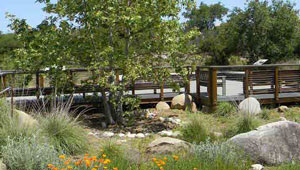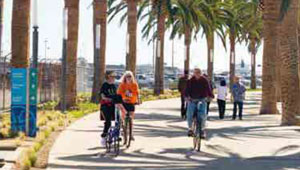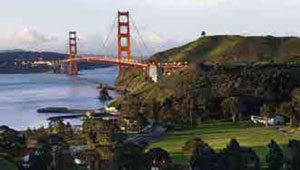California Council Key Issues
Water and Natural Resources
Landscape architects provide efficient, cost-effective, sustainable infrastructure solutions, effectively helping reduce energy requirements, managing stormwater, and reducing the need for valuable water resources in the built environment. Landscape architects use permeable paving, vegetated retention basins, green roofs, bioswales, rain gardens, and other design techniques to reduce runoff, improve water quality, and recharge groundwater supplies. They also use native and drought tolerant planting schemes and design highly efficient landscape irrigation systems.
Investing in Our Water Infrastructure
Issue
 The state depends on ample, clean water supplies to preserve health, to sustain a high standard of living and to maintain the quality of ecosystems. Water is a finite and valuable resource that is shared among human beings, and between human beings and ecosystems. Impervious surfaces caused by sprawling urban development increase volumes and rates of storm flows, carry pollutants into streams, prevent groundwater recharge, reduce stream base flows, and impact water temperatures. The unnecessary use of high water-demanding plants and unfit irrigation technology can increase consumption rates and waste water, while decreasing the resiliency of our urban spaces to withstand drought.
The state depends on ample, clean water supplies to preserve health, to sustain a high standard of living and to maintain the quality of ecosystems. Water is a finite and valuable resource that is shared among human beings, and between human beings and ecosystems. Impervious surfaces caused by sprawling urban development increase volumes and rates of storm flows, carry pollutants into streams, prevent groundwater recharge, reduce stream base flows, and impact water temperatures. The unnecessary use of high water-demanding plants and unfit irrigation technology can increase consumption rates and waste water, while decreasing the resiliency of our urban spaces to withstand drought.
Role of the Landscape Architect
For decades, landscape architects have used green infrastructure solutions to address problems related to stormwater and water-use. Landscape architects use natural landforms and techniques that replicate the natural hydrology of the landscape, which allows more water to remain on site, reducing the burden on storm drain systems and minimizing combined sewer overflows, all while greening the environment. In California, landscape architects are required to design planting and irrigation systems which conserve water and are resilient to drought conditions.
CCASLA Position
The American Society of Landscape Architects urges efficient use of available water supplies, equitable allocation of water resources, and the provision of safe drinking water. ASLA encourages land use practices that conserve and protect water resources and related ecosystems and eliminate all forms of water pollution.
- CCASLA urges multi-functional integration of water resource facilities with natural ecosystems and human communities.
- CCASLA supports the continued application and enforcement of AB1881 The Model Water Efficient Landscape Ordinance (MWELO).
Community Revitalization Through Parks
Issue
 People in many communities do not have access to outdoor open space. Parks and recreation spaces provide critical outlets for Californians to have much-needed physical activity, can serve as outdoor classrooms and can also serve as economic catalysts for municipalities—creating jobs, spurring private investments, and enhancing property values.
People in many communities do not have access to outdoor open space. Parks and recreation spaces provide critical outlets for Californians to have much-needed physical activity, can serve as outdoor classrooms and can also serve as economic catalysts for municipalities—creating jobs, spurring private investments, and enhancing property values.
Role of the Landscape Architect
Landscape architects are perhaps best known for the design of parks across the nation, whether creating new parks and recreation facilities or helping rehabilitate and maintain existing ones. Using their expertise, landscape architects design parks in ways that reflect community values, attract local economic development, increase nearby property values, address stormwater management needs, efficiently use water and help Californians achieve more healthy lifestyles.
Landscape architects design communities that support active and healthy lifestyles by linking homes, schools, businesses, parks, and recreation facilities together with walking and bicycle paths and sidewalks that provide safe and easy alternatives to driving.
CCASLA Position
CCASLA urges the Legislature to pass bills that recognize parks as vital components to infrastructure within communities, and that will provide assistance to communities who want to develop parks and recreation facilities so that neighborhoods may realize the myriad of benefits from these outdoor spaces. CCASLA advocates for parks funding, particularly in underserved communities, and recognizes that it can be more efficient to combine parks with schools in ‘joint use facilities’ so that resources may be maximized for outdoor environmental education and recreation.
Fixing Our Transportation Networks
Issue
 In order to provide balanced and equitable transportation alternatives like walking, bicycling, and access to public transportation, roadways need to be designed to make these options safe and attractive. However, most transportation rights-of-way are still designed exclusively for vehicles, often making travel conditions for pedestrians and bicyclists unsafe. ’Complete Streets’ accommodate all modes of transportation safely, and often involve a ‘road diet’, where existing vehicle lanes are reduced and replaced with wider sidewalks and bike lanes.
In order to provide balanced and equitable transportation alternatives like walking, bicycling, and access to public transportation, roadways need to be designed to make these options safe and attractive. However, most transportation rights-of-way are still designed exclusively for vehicles, often making travel conditions for pedestrians and bicyclists unsafe. ’Complete Streets’ accommodate all modes of transportation safely, and often involve a ‘road diet’, where existing vehicle lanes are reduced and replaced with wider sidewalks and bike lanes.
Role of the Landscape Architect
Using progressive planning and design principles, landscape architects help to create communities with transportation options that meet the needs of neighborhoods, with increased transit-oriented development and land patterns, sidewalks, bike lanes, paths, and trails that lead to schools, work, shopping, and other daily destinations. Enhanced access to public transportation is also key to successful land development patterns. Landscape architects are particularly adept at designing multimodal projects that are safe and attractive for users of all ages and abilities.
Landscape architects help communities by designing multi-use transportation corridors that accommodate all users, including pedestrians, bicyclists, motorists, people with disabilities, and people who rely on public transportation. These systems reduce reliance on single-use automotive transport, which in turn reduces traffic, improves air quality, and promotes a more active way of life.
CCASLA Position
CCASLA urges the Legislature to pass bills that lead to emissions reduction, directing funds towards non-vehicular modes of transportation; reducing greenhouse gases to enable priorities for pedestrian, bicycle and mass transit options; and establishing safety design criteria for bikeways throughout the state. Additionally, a Safe and Complete Streets policy for California will help fix our transportation networks to safely support all users, while also helping to create more economically vibrant communities.
- Transportation Legislation should be realistic, and make exemptions available for projects for which costs would be too prohibitive; for highways and other roads where pedestrians are not allowed; or where population, employment density, and transit service are so low that the expected users would not include pedestrians, bicyclists, and/or public transit users.
- Legislation should allow local agencies and MPOs to create their own policies.
Small Business Growth & Development

Small businesses are the backbone of the California economy and are helping with California’s economic recovery. According to the Bureau of Labor Statistics, small firms accounted for over 60 percent of all new jobs created in California since mid-2010. In landscape architecture, nearly all firms are designated as small businesses and they are doing their part to help jump-start California’s economy—creating jobs focusing on the planning and designing of critical infrastructure and other community assets, while fostering economic development. The Landscape Architecture profession is poised to lead jobs growth in the design professions in the coming years.
As California continues to rebound from the recent economic crisis, it is critical that the State Legislature continue to address policies that provide certainty and stability for small businesses and other entrepreneurs, so that they may operate in a stable regulatory and financial environment and help grow our economy. The California Council of the American Society of Landscape Architects (CCASLA) applauds the Legislature for passing policies that have helped small businesses, including regulatory reforms and the protection of legitimate business activities. These actions help small businesses, in general, and landscape architects, in particular, compete more fairly in the marketplace.
The Legislature can also continue to help small landscape architecture firms by passing policies that invest in the State’s infrastructure. As our infrastructure ages and requires repair and replacement, landscape architects’ unique skills are a part of the solution. Providing a bridge between the natural and built environments, landscape architects have the skills to help rebuild our communities—planning and designing multimodal transportation corridors, storm water management systems, urban parks and other recreational spaces and helping implement sustainable community strategies. California’s investment in these types of community projects will help create jobs throughout the design, construction, and supply industries, while also driving other community-based economic development. Landscape architecture firms play a significant role in these activities and provide value in an expanding economy.
